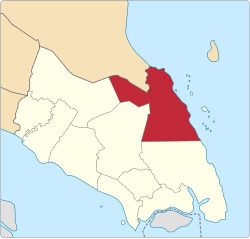Mersing District
 From Wikipedia - Reading time: 10 min
From Wikipedia - Reading time: 10 min
Mersing District | |
|---|---|
| Daerah Mersing | |
| Other transcription(s) | |
| • Jawi | مرسيڠ |
| • Chinese | 丰盛港县 |
| • Tamil | மெர்சிங் |
 Location of Mersing District in Johor | |
 | |
Location of Mersing District in Malaysia | |
| Coordinates: 2°20′N 103°40′E / 2.333°N 103.667°E | |
| Country | |
| State | |
| Seat | Mersing |
| Local area government(s) | Mersing District Council |
| Government | |
| • District officer | Asman Shah bin Abd Rahman |
| Area | |
• Total | 2,838.47 km2 (1,095.94 sq mi) |
| Population (2020)[2] | |
• Total | 78,195 |
| • Density | 28/km2 (71/sq mi) |
| Time zone | UTC+8 (MST) |
| • Summer (DST) | UTC+8 (Not observed) |
| Postcode | 86xxx |
| Calling code | +6-07 |
| Vehicle registration plates | J |
Mersing District is one of the 10 districts district in Johor, Malaysia. Its seat is located at Mersing Town.
Etymology
[edit]The "Mersing" name is derived from the Chinese "Mau Sheng Port" (茂盛港) since 1880 and further simplify to Mersing. Mersing's Chinese name was renamed to "Feng Sheng Port" (丰盛港), with the meaning of good harvest. There are also said that Mersing's name is derived from Sikh traders who named Amir Singh and Men Singh.[3]
Geology
[edit]Beside the mainland area, the district also consists of 36 islands.[4]
Geography
[edit]With an area of 2,838 km2, Mersing District is the third largest district in Johor, which covers 14.6% area of the state.
Demographics
[edit]| Year | Pop. | ±% | ||
|---|---|---|---|---|
| 1991 | 63,643 | — | ||
| 2000 | 67,605 | +6.2% | ||
| 2010 | 69,028 | +2.1% | ||
| 2020 | 78,195 | +13.3% | ||
| ||||
| Source: [5] | ||||
In 2000, the annual population growth of the district was 1.21%.[6]
Federal Parliament and State Assembly Seats
[edit]List of Mersing district representatives in the Federal Parliament (Dewan Rakyat)
| Parliament | Seat Name | Member of Parliament | Party |
|---|---|---|---|
| P154 | Mersing | Muhammad Islahuddin Abas | PN (BERSATU) |
List of Mersing district representatives in the State Legislative Assembly.
| Parliament | State | Seat Name | State Assemblyman | Party |
|---|---|---|---|---|
| P154 | N32 | Endau | Alwiyah Talib | PN (BERSATU) |
| P154 | N33 | Tenggaroh | Raven Kumar Krishnasamy | BN (MIC) |
Administrative divisions
[edit]
Mersing District is divided into 10 mukims, which are:[1]
- Jemaluang
- Lenggor[7]
- Mersing Town
- Padang Endau
- Penyabong
- Offshore islands (Aur Island, Dayang Island, Rawa Island, Tengah Island, Pemanggil Island, Sibu Island)
- Sembrong
- Tenggaroh
- Tenglu
- Triang
Economy
[edit]The main economy activities in the district are ecotourism, fishery, marine activities, agriculture and light manufacturing.[8]
Tourist attractions
[edit]- Aur Island
- Besar Island
- Harimau Island
- Mount Arong Recreational Forest
- Pemanggil Island
- Rawa Island
- Sibu Island
- Endau-Rompin National Park
Transportation
[edit]See also
[edit]References
[edit]- ^ a b "Pejabat Tanah Mersing". ptj.johor.gov.my.
- ^ "Population Distribution and Basic Demographic Characteristics, 2010" (PDF). Department of Statistics, Malaysia. Archived from the original (PDF) on 22 May 2014. Retrieved 19 April 2012.
- ^ "【柔佛10县名字由来】柔佛子民随堂考:10县名字由来,知道一半以上算你牛". JOHOR NOW 就在柔佛. 24 May 2017.
- ^ "Kedudukan Geografi". Portal Rasmi Majlis Daerah Mersing (in Malay). 22 December 2015. Retrieved 23 January 2018.
- ^ "Key Findings of Population and Housing Census of Malaysia 2020" (pdf) (in Malay and English). Department of Statistics, Malaysia. ISBN 978-967-2000-85-3.
- ^ Handbook johor.gov.my
- ^ "GeoJohor". Retrieved 27 October 2018.
- ^ "Muafakat ke Arah #Johor Berkemajuan" (PDF). Muafakat Johor (in Malay). Retrieved 17 March 2018.
 KSF
KSF

